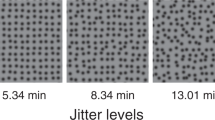Abstract.
We present a set of texture parameters that correspond to perceptual properties of visual texture. For machine vision or a computer interface, it is important that the computational measurements of texture correspond well to the perceptual properties. To understand the mechanism of our visual system, it is important to know how we extract or characterize information for texture perception. In this study, we show that the autocorrelation function (ACF) analysis provides useful measures for representing three salient perceptual properties of texture: contrast, coarseness, and regularity. The validity of the ACF analysis was examined by comparing the calculated factors to the subjective scores collected for various kinds of natural textures. The effectiveness of the analysis depends on the structure of the estimated ACF. When a texture has a harmonic structure, the estimated ACF has periodical peaks corresponding to the periods of the texture. Both perceived coarseness and regularity are strongly related to these peaks in the ACF. However, the estimated ACF does not have a periodical structure when the texture is random. In this case, the texture coarseness and regularity are represented by the decay rate of the ACF.








Similar content being viewed by others
References
Amandasun, M., & King, R. (1989). Textural features corresponding to textural properties. IEEE Transactions Systems, Man and Cybernetics, 19, 1264–1274.
Badcock, D. R., & Derrington, A. M. (1989). Detecting the displacement of spatial beats: No role for distortion products. Vision Research, 29, 731–739.
Ben-Av, M. B., & Sagi, D. (1995). Perceptual grouping by similarity and proximity: Experimental results can be predicted by intensity autocorrelations. Vision Research, 35, 853–866.
Brodatz, P. (1966). Textures. New York: Dover.
Campbell, F. W., & Robson, J. G. (1968). Application of Fourier analysis to the visibility of gratings. Journal of Physiology (London), 197, 551–566.
Cho, R. Y., Yang, V., & Hallett, P. E. (2000). Reliability and dimensionality of judgments of visually textured materials. Perception & Psychophysics, 62, 735–752.
Cross, G. R., & Jain, A. K. (1983). Markov random field texture models. IEEE Transactions Pattern Analysis and Machine Intelligence, 5, 25–39.
Francos, J. M., Meiri, A. Z., & Porat, B. (1993). Unified texture model based on a 2-D Wold-like decomposition. IEEE Transactions on Signal Processing, 41, 2665–2678.
Hammett, S. T., & Smith, A. T. (1994). Temporal beats in the human visual system. Vision Research, 34, 2833–2840.
Haralick, R. M. (1979). Statistical and structural approaches to textures. Proceedings of IEEE, 67, 786–804.
Heeger, D., & Bergen, J. (1995). Pyramid-based texture analysis/synthesis. In Proceedings of ACM SIGGRAPH.
Henning, G. B., Herz, B. G., & Broadbent, D. E. (1975). Some experiments bearing on the hypothesis that the visual system analyzes spatial patterns in independent bands of spatial frequency. Vision Research, 15, 887–897.
Julesz, B. (1962). Visual pattern discrimination. IRE Transactions on Information Theory, 8, 84–92.
Liu, F. (1997). Modeling spatial and temporal textures. PhD thesis, Massachusetts Institute of Technology.
Liu, F., & Picard, R. W. (1996). Periodicity, directionality, and randomness: Wold features for image modeling and retrieval. IEEE Transactions on Pattern Analysis and Machine Intelligence, 18, 722–733.
Malik, J., & Perona, P. (1990). Preattentive texture discrimination with early vision mechanisms. Journal of Optical Society of America A, 7, 923–932.
Mao, J., & Jain, A. K. (1992). Texture classification and segmentation using multiresolution simultaneous autoregressive models. Pattern Recognition, 25, 173–188.
Mayhew, J. E. W., & Frisby, J. P. (1978). Suprathreshold contrast perception and complex random textures. Vision Resarch, 18, 895–897.
Mosteller, F. (1951). Remarks on the method of paired comparisons: III. A test of significance for paired comparisons when equal standard deviations and equal correlations are assumed. Psychometrica, 16, 207–218.
Portilla, J., & Simoncelli, E.P. (2000). A parametric texture model based on joint statistics of complex wavelet coefficients. International Journal of Computer Vision, 40, 49–71.
Rao, A. R., & Lohse, G. L. (1996). Towards a texture naming system: Identifying relevant dimensions of texture. Vision Research, 36, 1649–1669.
Sakai, K., & Finkel, L. H. (1995). Characterization of the spatial-frequency spectrum in the perception of shape from texture. Journal of Optical Society of America, 12, 1208–1224.
Tamura, H., Mori, S., & Yamawaki, T. (1978). Textural features corresponding to visual perception. IEEE Transactions Systems, Man and Cybernetics, SMC-8, 460–472.
Thurstone, L. L. (1927). A law of comparative judgment, Psychological Review, 34, 273–289.
Tiippana, K., & Näsänen, R. (1999). Spatial-frequency bandwidth of perceived contrast. Vision Research, 39, 3399–3403.
Turner, M. R. (1986). Texture discrimination by gabor functions. Biological Cybernetics, 55, 71–82.
Uttal, W. R. (1975). An autocorrelation theory of form detection. Hillsdale, NJ: Erlbaum.
Zhu, S. C., Wu, Y. N., & Mumford, D. (1998). Filters, Random fields And Maximum Entropy (FRAME) – Towards a Unified Theory for Texture Modeling. International Journal of Computer Vision, 27, 1–20.
Author information
Authors and Affiliations
Corresponding author
Rights and permissions
About this article
Cite this article
Fujii, K., Sugi, S. & Ando, Y. Textural properties corresponding to visual perception based on the correlation mechanism in the visual system. Psychological Research 67, 197–208 (2003). https://doi.org/10.1007/s00426-002-0113-6
Received:
Accepted:
Published:
Issue Date:
DOI: https://doi.org/10.1007/s00426-002-0113-6




